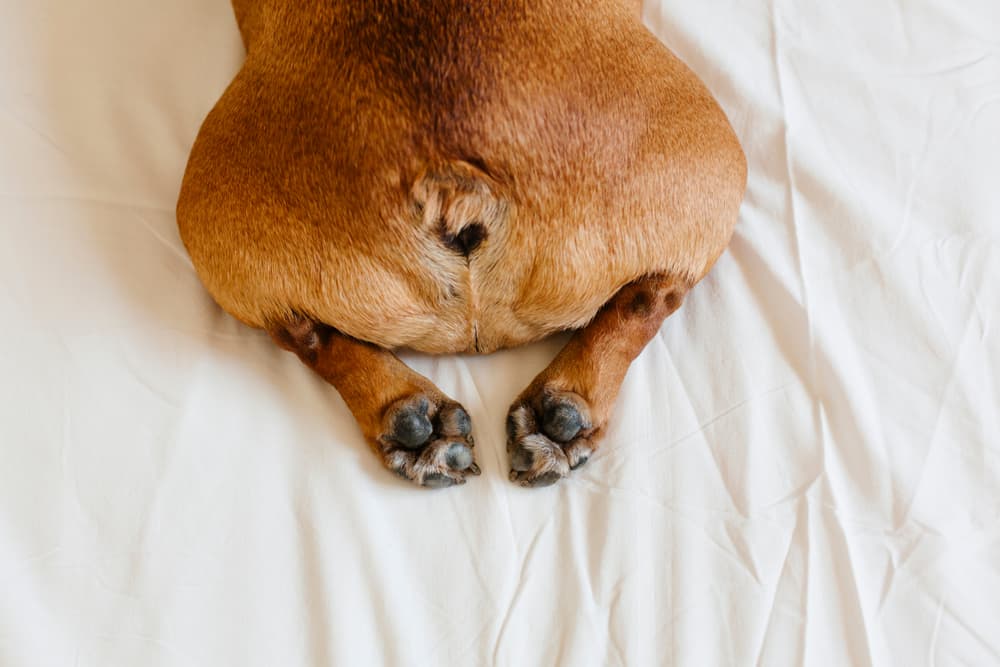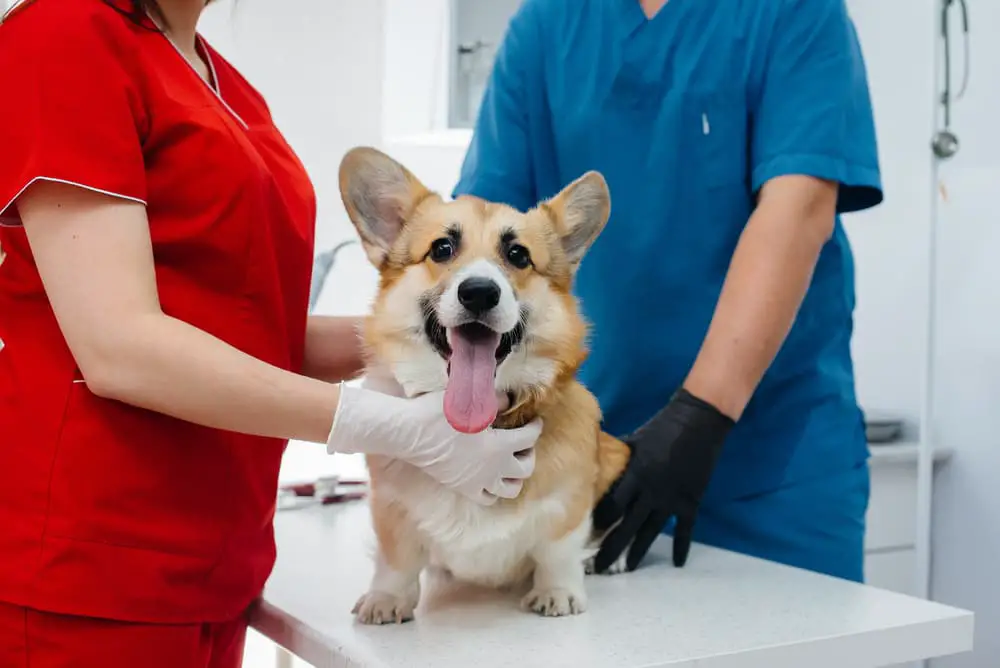It’s a behavior that all pet parents dread—their adorable dog dragging his butt across the carpet and the gross biting and licking that often comes with it.
Dog scooting is a sign that your canine companion is experiencing discomfort and it’s often related to anal gland problems, allergies, or irritation.
“Scooting is when a dog drags their bottom along the floor while in a seated position. This is a dog’s way of saying something isn’t right with their butt,” says Dr. Rachel Barrack of Animal Acupuncture in NYC. “It could be itchy or painful. It could be indicative of something mildly concerning or a sign of a more serious medical issue.”
To get to the bottom (pun intended) of your dog’s scooting, we asked veterinarians why dogs scoot, what causes this behavior, and what pet parents can do to help get their dogs some relief.
Why Do Dogs Scoot On Their Butt?

As previously mentioned, dogs scoot their butts on the floor or carpet if they are experiencing discomfort.
“Scooting is most commonly caused by anal gland problems, and the action of scooting is typically the dog’s attempt to relieve soreness,” says Dr. Shawna Garner, U.S. lead veterinarian at on-demand video consultation platform, FirstVet.
A dog’s anal glands are located below their tails. They are two small sacs located near the anal opening. These glands release a scent and send signals to other animals. “Each time a dog defecates, a small amount of the scent is emptied from the sac,” explains Garner. “When these glands become irritated, or inflamed, the scent liquid is trapped inside the glands and dogs may try to relieve the pain by scooting.”
There are other symptoms to be on the lookout for if you suspect your dog’s scooting is caused by impacted or irritated anal glands. “Chewing or licking at the bottom, thighs, tail base, or groin are all symptomatic behaviors,” says Garner. “You may also notice a strong fishy odor, usually around the bottom.”
But anal gland problems aren’t the only reason dogs may scoot their butts. According to Barrack, other causes of dog scooting include:
- General irritation (often seen after grooming)
- Allergies
- Parasites (especially tapeworms)
- Neoplasia (an abnormal growth of cells)
What Should You Do If You See Your Dog Scooting?

“If you see your dog scooting, lift up their tail and check for anything that might be causing the irritation. Unless you see an obvious and easily fixed cause (such as a piece of stick or poop stuck to their fur), get them checked out by a vet,” says Dr. Victoria Strong, a veterinarian, lecturer, and content writer. “Don’t leave it too long. Left untreated, blocked anal glands can develop into more serious issues such as infections and anal gland abscesses.”
Pet parents should not try to express or empty their dog’s anal glands at home or by taking a dog to the groomer, says Barrack. “This can cause trauma and more harm,” she says.
In fact, dogs should not regularly have their anal glands expressed as part of professional grooming services. “Normal dogs do not require frequent manual anal gland expression as they do this on their own when they defecate,” Barrack explains.
Dog Scooting Treatment

If your dog’s butt dragging is caused by anal gland problems, your veterinarian will likely empty your dog’s glands after a thorough physical exam, says Garner.
“In persistent cases, an anti-inflammatory may be prescribed to prevent swelling arising, and anal gland infections will require a course of antibiotics,” she adds. “In the most severe cases, surgery may be required to remove the anal glands. But this is a serious procedure and comes with significant risk, so it is important to discuss these risks with a vet before deciding on the best course of action for your pet.”
If your veterinarian treats your dog’s anal glands, your canine companion may start feeling relief rather quickly and the scooting should stop. “Relief from emptying the anal glands can be almost instantaneous,” says Strong. “In some dogs it might take up to 24 hours for the irritation to settle.”
Home Remedies for Dog Scooting
If your dog is already scooting and showing signs of discomfort, it’s always a good idea to visit your veterinarian for a thorough exam, proper diagnosis, and effective treatment plan.
However, there are some things that pet parents can do to try and help prevent scooting and anal gland problems from occurring.
Feed a high quality diet. “Feeding your dog a good quality, well-balanced diet can help prevent scooting by ensuring their stools are firm enough to squeeze and empty the anal glands as they pass through the rectum,” says Strong. “A good diet will also help you prevent obesity, which increases the risk of anal gland problem in dogs.”
Don’t skip parasite prevention. Since some dog scooting can be caused by parasites such as tapeworms, it’s important to keep your dog on a parasite preventative that protects against tapeworm infection.
Consider a fiber supplement. Adding fiber to your dog’s diet can help prevent some digestive issues and anal gland problems. “Adding fiber to your dog’s diet can help to maintain their digestive health, firm up their stools, and prevent their anal glands from becoming inflamed,” says Garner. “There are commercially available fiber supplements, or you could add dry bran flakes, oats, or cooked brown rice to their meal.” Plain canned pumpkin is also a good option for adding more fiber to your dog’s diet.
Fiber Supplements for Dogs: Our Favorite Picks
All featured products are chosen at the discretion of the author. However, Great Pet Care may make a small affiliate commission if you click through and make a purchase.
If your dog’s diet could use a fiber boost, these products can provide a range of digestive health benefits, from keeping your canine regular, to firming up loose stool and maintaining healthy anal gland function.
Great Poop Digestive Enzymes Support for Dogs

As every pet parent knows, poop happens. And fiber is key to ensuring your dog has good poop, which can help prevent the discomfort of an irritated rear. But why stop at good when your dog’s poop (and health) could be GREAT? Our pet experts packed everything your dog needs for a healthy, happy gut into a powerful high-fiber supplement that’s powerfully tasty, too. The delicious, chicken-flavored chews are fortified with probiotics and digestive enzymes, as well as fiber-rich natural ingredients like oat flour and flax seeds. So your dog will love the taste, while their gut will love the benefits: firmer, consistent poop, plus relief from gas, diarrhea, and bloating. And easier cleanup makes for happy pet parents, too.
Highlights
- 120 soft chews per container.
- A multifunctional formula to help with a variety of digestive issues.
- Made with high-quality ingredients including essential digestive enzymes, probiotics, and fiber.
- Flavored like chicken, so dogs will eat them easily.
- Made in the USA.
- No preservatives or fillers.
Things to Consider
- Only one flavor currently available.
- Dogs over 26 pounds will require more than one chew per serving.
Native Pet Organic Pumpkin Fiber for Dogs

For pet parents who turn to pumpkin as an all-natural remedy for scooting, as well as a variety of other digestive issues, Native Pet provides an easy-to-use solution: Simply mix a veterinary nutritionist-developed dose of Native Pet’s organic fiber powder with water and create a delicious (and healthy!) pumpkin puree. The powder has a longer shelf life and can be used as needed, where canned pumpkin will need to be tossed soon after opening. This formula contains only three organic ingredients and will help to combat diarrhea and loose stools.
Highlights
- Made with only three ingredients: organic pumpkin, pumpkin seed, and apple powders.
- Most customers see results in 2-4 days.
- Can be mixed with water or sprinkled over food.
- Average shelf life is 22 months!
Things to Consider
- It’s slightly pricey for an 8-ounce can. But, like we said, it lasts a long time.
- Some pet owners said it was a bit clumpy when mixed with water.
Virbac Vetasyl Fiber Capsules

For dog constipation relief and anal gland problems that can cause scooting, these fiber capsules from Virbac are gentle and effective. They are formulated with natural sources of fiber including psyllium and barley. The jar contains 500 capsules and they are simple to use. Just break them open and sprinkle the powder over your pup’s food.
Highlights
- Works for both dogs and cats, so great for multi-pet households.
- Contains no salts or sugars.
- Formulated with natural fiber sources.
- 500 capsules in a bottle is a nice amount for the price.
Things to Consider
- The capsules have to be broken open and sprinkled over food, which may not be appealing for picky eaters.
- Some reviewers didn’t like the odor of this product.
The post Dog Scooting: Why it Happens and How to Stop It appeared first on Great Pet Care.









